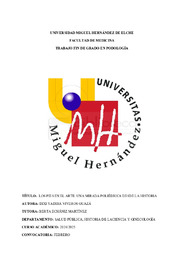Por favor, use este identificador para citar o enlazar este ítem:
https://hdl.handle.net/11000/36420Registro completo de metadatos
| Campo DC | Valor | Lengua/Idioma |
|---|---|---|
| dc.contributor.advisor | Echániz Martínez, Berta María | - |
| dc.contributor.author | Viveros Guazá, Dixi Yadira | - |
| dc.contributor.other | Departamentos de la UMH::Salud Pública, Historia de la Ciencia y Ginecología | es_ES |
| dc.date.accessioned | 2025-04-08T10:40:49Z | - |
| dc.date.available | 2025-04-08T10:40:49Z | - |
| dc.date.created | 2025-02-14 | - |
| dc.identifier.uri | https://hdl.handle.net/11000/36420 | - |
| dc.description.abstract | INTRODUCCIÓN: Los pies han trascendido su función básica como soporte físico para convertirse en símbolos de conexión con lo humano, lo cultural y lo natural. Desde la historia del cuerpo, la antropología histórica y la historia del arte, haremos un breve recorrido a través de sus representaciones en pinturas, esculturas, fotografías o performances, reflexionando sobre cómo son reflejo de la evolución histórica de imaginarios culturales y sociales. OBJETIVOS: Estudiar cómo ha sido el proceso de construcción sociocultural de los pies a través del arte. Analizar sus representaciones en diferentes períodos históricos. Comprender cómo fue evolucionando su percepción. Comparar los distintos significados sociales y culturales que fue adquiriendo. METODOLOGÍA: A partir del contexto historiográfico e iconológico se consultaron portales bibliográficos de literatura científica, artículos de revistas especializadas y se recurrió a préstamos interbibliotecarios/digitalización en la Biblioteca. No se limitó la búsqueda temporal para no excluir trabajos relevantes y no limitar el margen de búsqueda. RESULTADOS Y DISCUSION: En el cristianismo, por un lado, el pie representa lo divino, pero también el pecado y el mundo pagano. Descalzos los pies simbolizan la pobreza, la espiritualidad y la dinámica entre inferioridad y superioridad. En el erotismo aluden a lo pecaminoso y prohibido, mientras que, en el arte contemporáneo, sus representaciones se caracterizan por la interdisciplinariedad y la búsqueda constante de nuevos lenguajes. CONCLUSIÓN: A lo largo de la historia, las representaciones de los pies han ido cambiando su significado en función del contexto sociocultural, simbolizando desde humildad, divinidad, sumisión, adoración hasta pecado, sexualidad, pobreza o enfermedad | es_ES |
| dc.description.abstract | INTRODUCTION: Feet have transcended their basic function as a physical support to become symbols of connection with the human, the cultural and the natural. From the history of the body, historical anthropology and art history, we will make a brief journey through the representations of the foot through paintings, sculptures, photographs or performances, reflecting on how they reflect the historical evolution of cultural and social ideals. OBJECTIVES: To study the process of sociocultural construction of feet through art. Analyze their representations in different historical periods. Understand how their perception evolved. To compare the different social and cultural meanings that it acquired. METHODOLOGY: Based on the historiographical and iconological context, bibliographic portals of scientific literature, articles from specialized journals and interlibrary loans/digitization of the Library were consulted. Temporary search was not limited so as not to exclude relevant historical works and to expand the search margin. RESULTS AND DISCUSSION: The foot in Christianity on the one hand represents the divinity, but also sin and the pagan world. Barefoot, they symbolize poverty, spirituality, and the dynamic between inferiority and superiority. In eroticism it means the sinful and forbidden, while in contemporary art, their representations are characterized by interdisciplinarity and the constant search for new languages. CONCLUSION: Throughout history, representations of feet have changed their connotation depending on the social perception of each era and culture, symbolizing by humility, divinity, submission, worship, to sin, sexuality, poverty ot disease. | es_ES |
| dc.format | application/pdf | es_ES |
| dc.format.extent | 69 | es_ES |
| dc.language.iso | spa | es_ES |
| dc.publisher | Universidad Miguel Hernández | es_ES |
| dc.rights | info:eu-repo/semantics/openAccess | es_ES |
| dc.rights | Attribution-NonCommercial-NoDerivatives 4.0 Internacional | * |
| dc.rights.uri | http://creativecommons.org/licenses/by-nc-nd/4.0/ | * |
| dc.subject | Pies | es_ES |
| dc.subject | arte | es_ES |
| dc.subject | historia | es_ES |
| dc.subject | historia del arte | es_ES |
| dc.subject | antropología | es_ES |
| dc.subject.other | CDU::6 - Ciencias aplicadas | es_ES |
| dc.title | Los pies en el arte: una mirada poliédrica desde la historia | es_ES |
| dc.type | info:eu-repo/semantics/bachelorThesis | es_ES |

Ver/Abrir:
1767-VIVEROS GUAZÁ,DIXI YADIRA.pdf
8,16 MB
Adobe PDF
Compartir:
 La licencia se describe como: Atribución-NonComercial-NoDerivada 4.0 Internacional.
La licencia se describe como: Atribución-NonComercial-NoDerivada 4.0 Internacional.
.png)